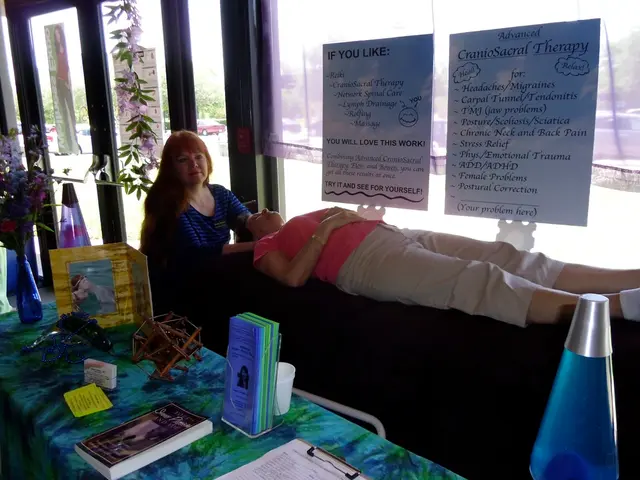Skin indications of elevated blood sugar: Identify 5 visible symptoms of diabetes
Diabetes, a condition characterised by high blood sugar levels, can have far-reaching effects on the body, including the skin. Here's a look at some of the ways diabetes can manifest on the skin and why it's crucial to monitor these signs.
According to the World Health Organisation (WHO), 14% of adults aged 18 years and above suffered from diabetes in 2022. This alarming statistic underscores the importance of understanding the potential skin symptoms associated with the condition.
One of the earliest and most common signs of high blood sugar levels is dry, cracked, and itchy skin. This occurs because high blood sugar pulls fluid out of tissues, making the skin dry and rough[1].
Another noticeable symptom is the appearance of dark patches of skin, known as acanthosis nigricans. These patches typically appear in skin folds such as the back of the neck and are due to insulin resistance causing rapid skin cell reproduction and discoloration[2][4].
Skin tags, small benign growths, frequently occur in people with insulin resistance and high insulin levels. Additionally, shiny, dented patches on the skin ("diabetic dermopathy"), caused by capillary damage and poor circulation, often seen on the shins or legs, are also common[1].
More serious skin conditions associated with diabetes include diabetic blisters (bullosis diabeticorum), digital sclerosis, necrobiosis lipoidica, and fungal or bacterial infections caused by impaired immune function[3].
Diabetes can also slow wound healing due to narrowed blood vessels and immune system impairment, making skin injuries more prone to infection[4]. This means that slow-healing wounds and cuts can be another symptom of the condition.
High blood sugar can also weaken the immune system, making it easier for bacteria and fungi to spread infection[5]. As a result, frequent skin infections, particularly fungal infections, could be a sign of high blood sugar.
Swelling in some parts of the skin, especially in areas that are more prone to infection, such as the legs or armpits, could also indicate high blood sugar[6].
Dark, velvety patches on the skin, usually around the neck, armpits or groin, can be a sign of high blood sugar and insulin resistance[7].
In conclusion, skin symptoms in diabetes reflect a combination of high blood sugar effects on circulation, immune response, and skin cell behavior, serving as important warning signs for disease management[1][2][3][4]. It's essential to monitor these signs and seek medical advice if concerned.
[1] American Academy of Dermatology. (n.d.). Diabetes and Your Skin. Retrieved from https://www.aad.org/public/diseases/a-z/diabetes-skin-care
[2] Mayo Clinic. (2021, January 25). Acanthosis nigricans. Retrieved from https://www.mayoclinic.org/diseases-conditions/acanthosis-nigricans/symptoms-causes/syc-20368000
[3] NHS. (2021, September 29). Diabetes and your skin. Retrieved from https://www.nhs.uk/live-well/healthy-body/diabetes-and-your-skin/
[4] WebMD. (2021, March 11). Diabetes and Your Skin. Retrieved from https://www.webmd.com/diabetes/guide/diabetes-and-your-skin
[5] Johns Hopkins Medicine. (n.d.). Diabetes and Your Immune System. Retrieved from https://www.hopkinsmedicine.org/health/conditions-and-diseases/diabetes/diabetes-and-your-immune-system
[6] Diabetes UK. (2021, October 1). Skin problems and diabetes. Retrieved from https://www.diabetes.org.uk/guide-to-diabetes/complications/skin-problems-and-diabetes
[7] American Diabetes Association. (n.d.). Diabetes and Skin Care. Retrieved from https://www.diabetes.org/healthy-living/medication-treatments/treatments-for-diabetes/skin-care
- India, with 14% of its adults suffering from diabetes in 2022, needs to focus on understanding the potential skin symptoms associated with the condition.
- Bollywood stars, like many Indians, should be aware of signs like dry, cracked, and itchy skin, dark patches, skin tags, and shiny, dented patches on the skin, which can be indicators of high blood sugar levels.
- In the field of science and health, it's crucial to research chronic diseases such as type-2 diabetes and their link to skin conditions, as poor management can lead to complications like diabetic blisters, digital sclerosis, necrobiosis lipoidica, and frequent skin infections.
- For medical-conditions like diabetes, health and wellness campaigns should focus on early detection methods, such as monitoring for slow-healing wounds, frequent skin infections, and swelling in skin areas prone to infection, which might indicate high blood sugar levels.




